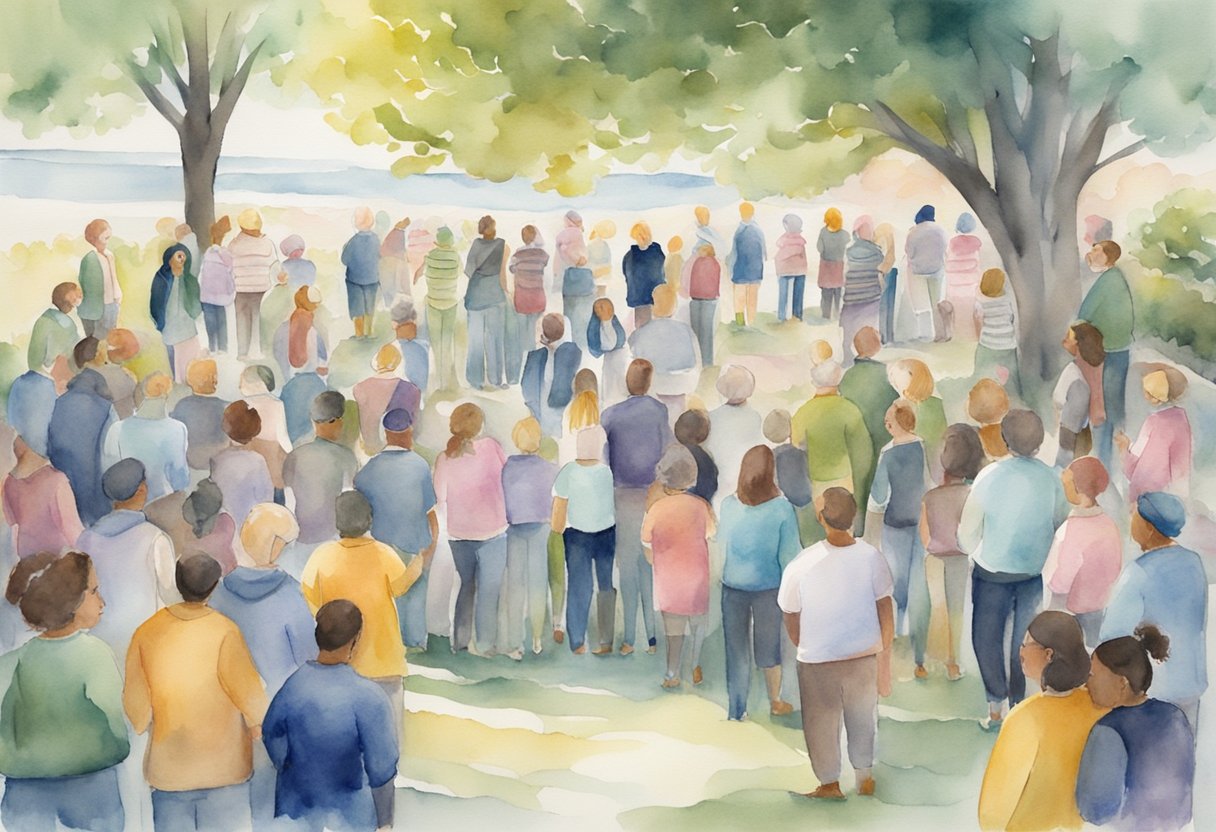Embracing Life After Cancer

The journey beyond cancer can be as challenging as the fight itself, yet it also opens a pathway to a unique kind of growth and resurgence. Surviving cancer twice has taught us the power of affirmative thinking—and how it galvanizes resilience.
We emerge as survivors and thrivers, bearing insights that can lead others through the darkness of illness into light. Embracing a healthy lifestyle and leveraging support systems create a foundation for sustained wellness, propelling us forward in post-cancer life.
As thrivers, we draw on every setback as a source of strength, transforming our experiences into a beacon for fellow men navigating the aftermath of cancer. We advocate for involvement in activities that bolster physical fitness and instill a sense of accomplishment and joy. Our stories testify to the indomitable spirit of human endurance and offer practical guidance for those seeking to reclaim their vitality.
Key Takeaways
- Affirmative thinking is central to transforming a cancer journey into one of thriving.
- Advocacy for physical health through sports fortifies long-term resilience in survivors.
- Sharing experiences provides a powerful support system for men overcoming cancer.
Understanding Cancer
This section will explore the various types of cancer and the genetic factors that may increase risk. Understanding these elements is crucial in prevention and management strategies for us all.
Cancer Types
Cancer manifests in many forms, each with unique characteristics and treatment approaches. Below is a table summarizing common cancers men might face, encapsulating the necessity for awareness and timely action.
| Type of Cancer | Affected Organ or Tissue |
|---|---|
| Prostate Cancer | Prostate Gland |
| Lung Cancer | Lungs |
| Colorectal Cancer | Colon or Rectum |
| Melanoma | Skin |
Screening for these cancers can lead to early detection, often resulting in better outcomes. For example, a regular colonoscopy can identify polyps before they evolve into colorectal cancer.
Genetics and Risk Factors
Our genetic makeup can play a pivotal role in our cancer susceptibility. While genes inherited from our parents cannot be altered, recognizing their impact aids us in adopting vigilant screening practices.
Notable Genetic and Risk Factors:
- Family History: A strong history of cancer in the family may suggest a genetic predisposition.
- Lifestyle Choices: Smoking, excessive alcohol consumption, and a sedentary lifestyle increase our risk.
- Age: As we age, the risk of developing cancer typically increases.
- Environment: Exposure to carcinogens like asbestos or prolonged UV radiation can elevate our risk.
Combining knowledge of these risk factors with proactive measures such as lifestyle adjustments and regular check-ups strengthens our defense against cancer. Through collaboration, education, and awareness, we enhance our collective capacity to thrive after a cancer diagnosis.
Diagnosis and Treatment

Facing a cancer diagnosis propels us into a complex journey of careful evaluation and decisive action. This journey begins with a thorough diagnosis process and the selection of the most effective treatment options.
Diagnosis Process
The initial step in confronting cancer is to undergo a comprehensive Diagnosis Process. We start with recognizing the signs & symptoms that may suggest cancer, leading us to seek medical advice. Exams & tests then play a crucial role; these often include blood tests, imaging scans like CT or MRI, and biopsies to determine the presence and type of cancer. Understanding the diagnosis & staging informs us about the extent of the cancer, which is vital for tailoring our treatment plan.
Treatment Options
Once diagnosed, we explore Treatment Options. These options vary widely; common treatments include surgery, chemotherapy, and radiation, often used in combination. In medicine, targeted therapies and immunotherapies have emerged as powerful tools, particularly effective for certain male cancers. During treatment, we focus on maintaining our strength through balanced nutrition and staying as active as our condition allows, which might include participating in sports or other physical activities to support our wellbeing and resilience.
Survivorship and Recovery
As we move beyond the rigors of treatment, we enter a phase where careful attention to post-treatment care and the nuances of long-term survivorship becomes central to our journey.
Post-Treatment Care
Our bodies and spirits require tailored care after the final infusion and the last radiation session. We develop a survivorship program geared toward men recovering from cancer, which includes regular health check-ups, management of treatment side effects, and strategies for emotional wellbeing.
Exercise emerges as a vital component, fostering strength and enhancing mood in a way comparable to the vitality of a well-trained athlete. This approach is not a mere suggestion but a structured part of recovery, as crucial to us as a playbook is to a team gearing up for the next challenge.
Long-Term Survivorship
The road of long-term survivorship, much like a marathon, demands persistence and resilience. Nurturing a support network strengthens our capacity to thrive, while participation in survivorship activities can help us feel part of a community. We learn to monitor for potential late treatment effects and stay vigilant for signs of recurrence, always in consultation with our healthcare team.
Furthermore, we focus on crafting a lifestyle conducive to long-term wellness, incorporating a balanced diet, regular physical activity, and stress management techniques into our daily regimen, creating a blueprint for enduring health.
Emotional Wellbeing
As survivors, we know that our emotional landscape changes profoundly post-treatment. We face a range of emotions, from relief to uncertainty.
Coping with Emotions
Stress and fear often walk hand in hand with cancer recovery. We acknowledge these emotions, and rather than let them control us, we use them as signals to seek emotional support. One practice that helped me considerably was holding regular discussions with fellow survivors, forging bonds that provided a safety net for when anger or guilt surfaced.
- Engage with support groups: Share experiences and gain perspective.
- Practice Mindfulness: Stay present, easing stress arising from future worries.
Building Resilience
Resilience becomes our shield and our beacon. It’s built through daily practices and small victories culminating in a renewed sense of self. Affirmations are a cornerstone here, simple yet powerful reminders that we steer our journey. Every morning, I recite tailored affirmations to bolster my courage and determination.
- Daily Affirmations: Reinforce self-belief and direction.
- Physical Activity: Choose your preferred sport to release tension and build physical and emotional strength.
Our collective experience shows us that men facing cancer thrive when we tackle our emotional wellbeing with the same tenacity we bring to physical recovery.
Physical Health and Lifestyle

After overcoming lymphoma, we understand that embracing a lifestyle that promotes physical wellbeing is crucial. Our bodies have been through an arduous journey, and we must nurture them back to strength.
Exercise and Activity
We can’t overstate the rejuvenation that regular exercise brings to our lives. Engagements like walking, swimming, or gardening can help combat fatigue and manage some long-term side effects of cancer treatments. We should aim for at least 150 minutes of moderate activity weekly, complemented by two sessions of muscle-strengthening activities. Always consult with a healthcare provider to tailor an exercise routine that fits with our recovery and lifestyle.
Diet and Habits
We fuel our recovery with nourishing meals—rich in vegetables, fruits, proteins, and whole grains. Not just what we eat but also our habits shape our wellbeing. Balance is key, as is mindful consumption of alcohol and a complete avoidance of tobacco. Proper sleep hygiene also plays a pivotal role; it allows our body to repair and prepare for the days ahead. Let’s stay consistent with these habits to maintain our health and vitality.
Support Systems

In our journey after cancer, we find strength in unity and shared experiences. Constant engagement creates a healing environment for both the body and spirit.
Finding Community
We seek spaces to connect with survivors and caregivers who understand our struggles. Support groups serve as a cornerstone for us, offering a platform to exchange stories, offer encouragement, and forge lasting bonds with those who face similar challenges. Through the cancer survivors network, we establish a crucial support structure that anchors us throughout our recovery and beyond.
Professional Resources
Equally vital are the professional resources tailored to our specific needs as cancer patients. Recognizing that emotional health is as critical as physical healing, we pursue patient programs designed to bolster our resilience. Facilities provide comprehensive care, encompassing not just the medical aspects but also the essential psychological and emotional support for us, especially for men who might be less likely to seek help.
These programs are our teammates, guiding us through rehabilitation with expertise and understanding. For instance, through resources like Cancer Survivorship Program | After Cancer | Stanford Medicine, we receive structured support that acknowledges our unique experiences and fosters our path to thriving after cancer.
Advocacy and Involvement

As survivors who have faced the trials of cancer, we know the incredible value of joining hands for a cause that impacts so many lives. Our collective strength stems from taking actionable steps towards spreading awareness and aiding others through their journeys.
Cancer Awareness Initiatives
Cancer takes no prisoners, affecting men and women alike. Our advocacy begins with education and awareness – key strides toward early detection that can save lives. By participating in campaigns and forums by organizations like the American Cancer Society, we use our voices to dispel myths and provide clarity. We share our stories to inspire and listen to understand the varied experiences accompanying this condition.
- Educate: Host community seminars on the lesser-known signs of cancers prevalent among men.
- Share: Offer our narratives in support groups and social media to encourage those in the fight.
Volunteer and Philanthropy
Our commitment doesn’t end with words; it echoes in our actions. Volunteering our time and organizing philanthropic events allows us to extend a hand to our fellows enduring the same struggles. Whether it’s being present at hospital visits, participating in fundraising sports events, or contributing resources to cancer research, every act of kindness births hope.
- Support: Join hands with local chapters to provide aid directly to those affected.
- Fundraise: Engage in sports-based charity events to raise money for research and support services.
By advocating, volunteering, and giving, we exemplify what it means to be true thrivers. It’s not in the grand gestures but in the quiet moments of solidarity where we find our shared resilience. Together, we make a tangible difference.
Final Thoughts…

We embark on journeys unique to each one of us, especially after surviving challenges like lymphoma. Affirmations are a powerful tool on this path, acting as beacons that light our way through the uncertainties. In our collective resilience, these positive statements reinforce our strength and capacity for healing.
For us men facing cancer, it’s essential to build a community where we can exchange these affirmations and support each other. Sharing success on the field or backing one another in our fitness goals can foster a sense of camaraderie and shared purpose. As we navigate our recovery, we find solace in teamwork and the collective push towards wellness.
List of Affirmations for Fellow Survivors:
- We are more potent than the challenges before us.
- We find solace in unity and shared experiences.
- Every day, we celebrate a collective win for health.
- Our stories inspire courage and hope.
During my encounter with cancer twice, I found that affirmations gave me the resilience necessary to move forward. It’s not just about the words we say; it’s about the actions we take. Staying active, involved in sports, or even simple daily exercises can be transformative. We use these actions to express our determination and foster a positive mindset.
Let’s carry forward this ethos of positive resurgence. Together, we build a tapestry of triumph woven with threads of our fierce will, unwavering spirit, and the supportive bonds we share. -T
Frequently Asked Questions
Within our community, we frequently encounter insightful inquiries that reflect our collective experiences and perseverance. Let’s explore these pivotal questions together.
How can maintaining a positive outlook influence the recovery process in cancer patients?
Nurturing a positive mindset fosters resilience, pushing us through grueling treatments and enabling us to find joy even on rough days. Our resolve to heal can indeed bolster our physical recovery.
What are strategies for staying resilient during a cancer journey, particularly in advanced stages?
We engage with our passions, whether cheering for our favorite sports teams or hitting the court ourselves. This reminds us that our strength transcends cancer. Additionally, setting tangible goals gives us milestones to strive for, imparting a sense of progress and determination.
What defines a ‘cancer thriver,’ and how does this perspective impact survivorship?
A ‘cancer thriver’ isn’t just someone who survives but embraces life zealously and seeks growth amidst the struggle. Our thriver mindset affirms our resolve to live fully, enriching our survivorship with purpose and tenacity.
What is the likelihood of cancer reoccurring, and how can survivors prepare for this possibility?
The risk of recurrence varies by cancer type and individual circumstances. We stay vigilant by scheduling regular check-ups and creating action plans with our medical teams. This proactive approach keeps us equipped to face any scenario head-on.
In what ways can cancer return be more aggressive, and what implications does this have for patient care?
Occasionally, cancer’s return can present a more formidable challenge. We then count on our medical teams to adapt our care with enhanced treatments, tapping into the latest breakthroughs to outsmart aggressive cells.
Can you describe the difference between cancer recurrence and relapse and the significance of each in patient prognosis?
Recurrence is when cancer reappears after a period of being cancer-free, while a relapse indicates that the disease never entirely left us. Each scenario guides our treatment plan, underscoring our journey’s need for tailored care and vigilance.
